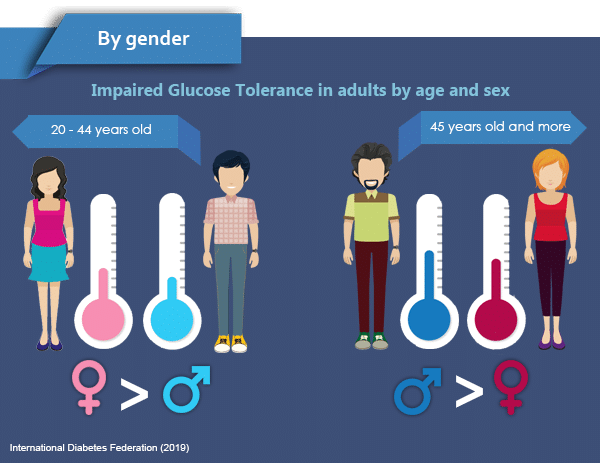
Diabetes is a chronic disease linked toa dysfunction of the pancreas, which produces little or no insulin. It is characterised by an abnormally high level of glucose in the blood, with the sugar stagnating in the blood instead of migrating to the organs. It affects around 3.5 million people in France alone, including people with highly diverse backgrounds.
A 2018 study published in BMJ Open Diabetes Research and Care found that women who worked more than 45 hours per week were at greater risk of developing diabetes than those who worked 35 to 40 hours per week. Conversely, the more men work, the lower the incidence of diabetes.
But does female-male inequality really exist with regard to diabetes (type 1 or 2) and prediabetes?
Examining data from IDF Diabetes Atlas (2019) which lists all the data available in the world, continent by continent, according to age group and sex (male/female) and data from InVS, the French health monitoring institute, it is not immediately clear.
To answer the question, you have to look at the data
The estimated global prevalence of diabetes (types 1 and 2) in women aged 20 to 79 is slightly lower than in men. This is the case in Europe, for example, where the difference is greatest in the 50-69 age group. However, after the age of 70, there are almost as many women as men with diabetes, with mortality due to the disease much higher in women.
In contrast, the situation is different in Africa and Central and South America, where women are more affected by diabetes than men, regardless of the age group. Criteria such as living standards and genetics can largely explain these differences.
Putting aside the gender issue, global inequalities in terms of access to quality healthcare arealso a factor in the prevalence of diabetes. Where such access is not available, diabetes goes undiagnosed or misdiagnosed, and patients do not have access to much-needed medical equipment and medicines such as insulin.
As for prediabetes globally, it seems that women are more affected before the age of 45 and are affected less than men after the age of 45.

Diabetes and prediabetes are therefore not primarily a matter of sex. Any individual can have high and unpredictable blood sugar due to reasons such as stress, co-morbidities, nutritional imbalances and lack of exercise. Simple solutions can prevent prediabetic people from becoming diabetic.
An exclusively female form of diabetes
In France, gestational diabetes affects around 7% of pregnant women. This form of hyperglycaemia appears at the end of the second or third trimester of pregnancy. It is linked to abnormal secretions of insulin. Insulin is secreted in greater quantities during pregnancy due to the increase in hormones, but it is less effective. The management of a patient with gestational diabetes includes the introduction of enhanced self-monitoring of blood sugar, a diet suitable for diabetics, appropriate physical activity and even insulin treatment if necessary.
Pregnant women are more at risk of developing gestational diabetes if they have a history of diabetes in previous pregnancies. Other risk factors are being overweight or obese and women over the age of 35. The main danger of gestational diabetes is premature or caesarean delivery. Expectant mothers can develop high blood pressure and are more prone to developing type 2 diabetes over their lifetime.
Babies are also at risk. If gestational diabetes is left unchecked in the mother, it can lead to the baby being overweight, a condition known as macrosomia. Various risks can arise from macrosomia, such as nervous or cardiac malformations and hypoglycaemia at birth, in which case the baby must be fed very quickly after coming into the world.
Fortunately, this form of diabetes disappears after childbirth, when the placenta, which contains the hormones responsible for excessive secretion of ineffective insulin, is released. Gestational diabetes is therefore the only form of the disease which affects exclusively women. According to the data that has been collected, diabetes is a chronic disease that affects more men than women if we look at sex as an influencing factor in the illness.
- Always bear in mind that the higher the glycaemic index, the faster sugar in food passes into the blood.
- Cooking food promotes a high glycaemic index (for example, cooked carrots and potatoes).
- At breakfast, always introduce a protein to avoid 11am hypoglycaemia (ham or eggs).
- Avoid breakfast cereals which create rapid glycaemic indexes with the risk of hypoglycaemia.
- Choose wholemeal or semi-wholemeal bread or pasta and wholemeal rice.
- Give preference to green vegetables and fresh fruits, which allow cells to be more sensitive to insulin.
- Glycaemic index table (M. Montignac)
Our latest publications
Want to learn more about topics related to blood sugar management?
Here are our most recent blog posts!


